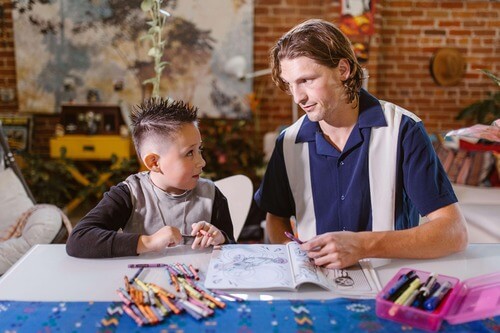The Best Parenting Styles for ADHD: A Guide to Raising a Thriving Child
When raising a child with ADHD, it often feels like the rule-book has been thrown out the window. You might wonder if a strict approach is best, or if a more flexible style would work better.

In this guide, we’ll go over some effective parenting styles for children with ADHD, backed by expert recommendations, research-based strategies, and real-life experiences.
Whether you're looking for structure, discipline strategies or emotional support techniques.
Why Parenting Style Matters for ADHD
Children with ADHD often struggle with impulsivity, emotional regulation, and maintaining focus.
Using the wrong parenting style can lead to frustration for both you and your child, however, if the right approach is used you can help them develop confidence and emotional stability.
Let’s look into the best parenting styles to support ADHD children while still setting the necessary boundaries.
1. The Best Parenting Style: A Balance of Structure and Nurturing
While there is no single parenting style that works for all children with ADHD, research shows that a blend of authoritative and positive parenting strategies yields the best results.
Authoritative Parenting: Structure with Warmth
An authoritative parent is firm yet understanding—they set clear rules and expectations while providing emotional support and flexibility. This is the sweet spot for children with ADHD.
How It Helps:
✅ Consistency: ADHD brains thrive on predictability and routine.
✅ Clear Expectations: Kids understand what’s expected of them without feeling overwhelmed.
✅ Emotional Support: Mistakes are treated as learning experiences rather than punishable offenses.
How to Apply It:
- Set clear and reasonable rules. Instead of saying, “Stop being so hyper!” try, “We use our indoor voice in the house.”
- Use natural consequences instead of harsh punishments. If your child forgets their homework, don’t scold—help them brainstorm ways to remember next time.
- Offer choices to foster independence. Example: “Would you like to do your homework at the kitchen table or your desk?”
2. Positive Parenting: Encouragement Over Punishment
Positive parenting is less about discipline and more about reinforcing good behavior. Studies show that kids with ADHD respond better to praise and incentives than to punishment.
How It Helps:
✅ Boosts self-esteem—reduces the feeling of always being “in trouble.”
✅ Encourages effort rather than perfection.
✅ Teaches problem-solving instead of triggering meltdowns.

How to Apply It:
- Catch them being good. Instead of only noticing what they do wrong, praise their efforts. Example: “I love how you started your homework right away!”
- Use rewards, not bribes. Offer small, meaningful incentives for good behavior—like extra playtime if they finish chores without reminders.
- Reframe “bad” behavior as a learning opportunity. Instead of saying, “Stop fidgeting!” try, “I see you have a lot of energy. Let’s take a quick movement break.”
3. What Parenting Styles to Avoid
Not all parenting styles work well for ADHD. Here are a couple that tend to backfire:
🚫 Authoritarian Parenting (Too Strict): Overly strict parenting can make kids with ADHD feel ashamed or rebellious. If they constantly feel like they can’t meet expectations, they may act out even more.
🚫 Permissive Parenting (Too Lenient): On the other hand, a lack of structure can be overwhelming. Kids with ADHD need boundaries to feel safe and secure. Without clear rules, they struggle with self-regulation.
🚫 Inconsistent Parenting: ADHD children do best with predictability. If you enforce rules one day but let them slide the next, it can lead to confusion and more impulsivity.
4. Practical Strategies for ADHD-Friendly Parenting
🔹 Build a Daily Routine (and Stick to It!)
Consistency is key for kids with ADHD. Having a structured routine helps them feel safe and in control.
✅ Morning Example:
- Wake up at the same time every day
- Use a visual checklist for getting dressed, brushing teeth, and packing a backpack
✅ Evening Example:
- Homework → Playtime → Dinner → Bedtime story → Sleep
🔹 Discipline with Connection, Not Punishment
Instead of yelling, use calm, direct consequences that teach responsibility.
✅ Example: Instead of “You’re grounded for not listening!”, try:
👉 “I see you’re having trouble following the rule about screen time. If you turn off the TV now, we can still have playtime later.”
👉 If they continue: Follow through with a logical consequence: “Since you didn’t turn off the TV, we’ll have to reduce screen time tomorrow.”
🔹 Help with Emotional Regulation
Kids with ADHD often have big emotions. Teach them to recognize and manage their feelings.
✅ Strategy: Use “emotion coaching.”
- “I see you’re feeling frustrated. Let’s take three deep breaths together.”
- “It’s okay to be mad. Instead of hitting, let’s stomp our feet to get the anger out.”
🔹 Encourage Movement Breaks
Kids with ADHD have a lot of energy. Instead of punishing fidgeting, channel it positively.
✅ Try These:
- Let them do homework standing up
- Use fidget toys during quiet time
- Allow short breaks for jumping jacks or stretching
5. The Role of Therapy and Support
Parenting a child with ADHD can be challenging—but you’re not alone. Professional guidance can make a huge difference.

🔹 Consider These Options:
- Parent Training Programs: Learn ADHD-specific discipline strategies
- Therapy for Your Child: Helps with emotional regulation
- Parenting Support Groups: Get encouragement and advice from other parents whose children have ADHD.
Final Thoughts: Embrace the Journey
For a child with ADHD it's about eliminating their challenges and helping them to navigate life with confidence.
By combining structure, positive reinforcement, and emotional support, you can create an environment where your child doesn’t just cope… they thrive.
🌟 Remember: Your child isn’t being “difficult” on purpose. Their brain is just wired differently, so help them build the skills they need to succeed by implementing the right parenting style while still setting necessary boundaries.
🔹 What’s your biggest ADHD parenting challenge? Drop a comment below—we’d love to hear from you!
Bonus Resources
📚 Recommended Reads:
- “The Explosive Child” by Dr. Ross Greene
- “Parenting ADHD Now!” by Elaine Taylor-Klaus
- “Taking Charge of ADHD” by Dr. Russell Barkley
🔗 Further Support:
- ADHD Parenting Courses - ADDitude Magazine
- Therapist Finder - Psychology Today
Raising a child with ADHD is a journey filled with ups and downs, but you’re already taking the first step—learning what works. With patience, love, and the right strategies, you can help your child shine. 💙









